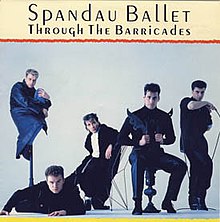Through the Barricades (song)
"Through the Barricades" is the title track of Spandau Ballet's 1986 album Through the Barricades. Released as a single, "Through the Barricades" entered the UK singles chart on 8 November 1986 and became the band's tenth and final top ten single, peaking at number six and spending a total of ten weeks on the chart.[1]
| "Through the Barricades" | ||||
|---|---|---|---|---|
 | ||||
| Single by Spandau Ballet | ||||
| from the album Through the Barricades | ||||
| Released | October 1986 | |||
| Recorded | September 1985-Summer 1986 in Munich, Germany & the South of France | |||
| Genre | Soft rock, pop rock, blue-eyed soul | |||
| Length | 5:59 | |||
| Label | Epic, CBS Records | |||
| Songwriter(s) | Gary Kemp | |||
| Producer(s) | Gary Langan/Spandau Ballet | |||
| Spandau Ballet singles chronology | ||||
| ||||
Background
The song was written about the death of Thomas Reilly, who had worked for the band, a death committed by a soldier in Belfast during the Troubles on 9 August 1983.[2] In 2015, songwriter Gary Kemp spoke to the Belfast Telegraph about his inspiration for it:
We had a guy called 'Kidso' (Thomas Reilly), who worked for us on merchandise during the True tour. He went back to Belfast after the tour and was killed. Kidso's brother, Jim, who played drums for Stiff Little Fingers, subsequently took me along to see his grave and the song was inspired by walking down the Falls Road. I got to experience some of the emotion of that first-hand and it just stuck with me. I didn't expect it to come out in the shape of a Romeo and Juliet sort of song, but it did.[2]
Accepting his award for Outstanding Song Collection at the 2012 Ivor Novello Awards, Kemp singled it out as a particular favourite of his, stating: "'Through the Barricades' is one I'm really close to".[3] Tony Hadley said that he considers it to be the band's best song.[4]
Reception and legacy
The song, which is in the form of an acoustic ballad, has been described by AllMusic as "the best song by far" on its album.[5] However, Ian Gittins was critical of the song in The Guardian, describing it as "one of Spandau's more ponderous, clunky numbers".[6]
Tony Hadley performed the song as part of his three-song set in the final of ITV reality show Reborn in the USA in 2003, which saw him win the public vote against Michelle Gayle.[7]
Charts
| Chart (1986) | Peak position |
|---|---|
| Italy (FIMI)[8] | 2 |
| UK Singles (Official Charts Company)[9] | 6 |
Certifications
| Region | Certification | Certified units/sales |
|---|---|---|
| Italy (FIMI)[10] | Gold | 25,000 |
|
| ||
References
- David Roberts, British Hit Singles and Albums, Guinness World Records Limited, p 518
- "Gary Kemp: When we played Through the Barricades in Belfast the reaction was incredible". Belfast Telegraph. 13 February 2015. Retrieved 6 June 2019.
- "Gary Kemp 'Complete' With Ivor Novello Award". Contact Music. Retrieved 18 June 2013.
- Bernstein, Jonathan (4 October 2014). "Spandau Ballet's True story: 1980s pop stars on how their hits were written". The Daily Telegraph. Retrieved 6 June 2019.
- LeRoy, Dan. "Through the Barricades". AllMusic. Retrieved 4 May 2014.
- Gittins, Ian (1 October 2014). "Spandau Ballet review – return of the shoulder-heaving soul boys". The Guardian. Retrieved 6 June 2019.
- "Hadley wins Reborn contest". BBC News. Retrieved 18 June 2013.
- "List of hit singles in Italy, during the '85/'86/'87 period" (in Italian). Hit Parade Italia. Retrieved 3 February 2019.
- "Official Singles Chart Top 100". Official Charts Company. Retrieved 16 December 2019.
- "Italian single certifications – Spandau Ballet – Through the Barricades" (in Italian). Federazione Industria Musicale Italiana. Retrieved 16 December 2019. Select "2019" in the "Anno" drop-down menu. Select "Through the Barricades" in the "Filtra" field. Select "Singoli online" under "Sezione".